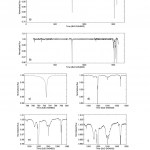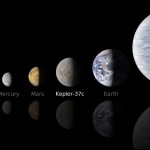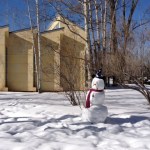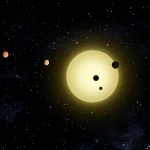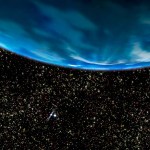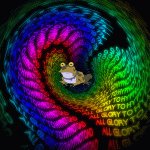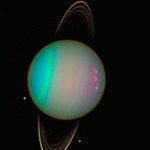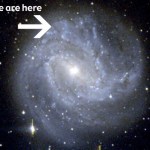Kepler
Tabby's Star - KIC 8462852 - remains one of the more interesting and mysterious objects in the sky.
There is a good update at "Updates on Boyajian’s Star" - Astrowright's blog and "Bradley Schaefer: Further Thoughts on the Dimming of KIC 8462852" at Centauri Dreams has the latest on the controversy over whether the star has undergone long term fading.
Update: "The Most Mysterious Star in the Galaxy" - another guest blog by Schaefer providing a good overview of the issues.
Ultimately to resolve this more data is needed.
There is a Kickstarter Project - "The most mysterious star in the Galaxy…
Ethan Kruse has update the Kepler Orrery, just in time for Extreme Solar Systems III now under way.
Enjoy
The Kepler 2 mission serendipitously observed Neptune about a year ago.
The images were posted on the K2 website, but according to the website stat like nobody shared them, which sucks.
The animation was just shown at the Division for Planetary Sciences meeting, #DPS15, in DC so it is time to show it again.
Enjoy.
Kepler Observes Neptune Dance with Its Moons
Check Emily Lakdwalla's planetary blog for #DPS15 news
As of this morning we have discovered over 1,500 exoplanets, planets orbiting stars other than the Sun.
In addition to the confirmed discoveries, we have over 3,000 candidate exoplanets, most discovered by the NASA Kepler Mission through transits, where we see the shadow of a planet as it crosses in front of its parent star.
We know, statistically, that most of the candidate planets are real, but a few % are weird misalignments of something else that makes us think there might be a planet there. Filtering those out is hard.
We also see other things, weird and wonderful things...
Little over…
On Life Lines, Dr. Dolittle examines the fascinating parallels between hummingbird and insect flight. He and/or she writes: "The researchers placed nontoxic paint on the wing of a ruby-throated hummingbird at 9 different spots then videotaped the animal flying at 1,000 frames per second with 4 cameras simultaneously." Despite being far removed from insects on the phylogenetic tree, hummingbirds "stir up air around their wings in a way similar to insects like mosquitoes and dragonflies." This is an example of convergent evolution, as natural selection engineers similar solutions for very…
Big Eyed Beans from Venus - Captain Beefheart and his Magic Band!
Cool. Literally
Comparable to Mars in effective temperature, bit larger than Earth, probably slightly more massive than Earth (mean density could be lower), atmosphere unknown.
Might well have extensive surface regions with persistent liquid water.
Kepler-186f comparison
"You can spend too much time wondering which of identical twins is the more alike." -Robert Brault
You've of course heard by now the news that Kepler, the most successful and prolific planet-finding mission of all time, has probably reached the end of its useful lifespan.
Image credit: NASA / Kepler Mission / Wendy Stenzel.
With nearly 3,000 planet candidates under its belt, including many approximately Earth-sized (and some even smaller), and many within their parent star's habitable zone, we now know that, at least planet-wise, we're not alone in our galaxy.
Image credit: NASA Ames /…
I come to praise Kepler, not to bury it...
Kepler!
The Kepler Mission is one of the little NASA spacecraft that so frequently comes along, exceeds all expectations and changes our perspective of the universe.
There is a good Quick History of the transit method and Kepler Mission concept on the website.
Otto Struve noted in his seminal 1952 note that planetary "eclipses" of their parent stars ought to be detectable by photoelectric methods, a proposal that some two decades later was quantified by Rosenblatt, and then explored in detail (including development research) by Borucki and…
There were a number of interesting results reported today, the start of what promises to be an interesting week:
IR spectra of HR 8799 planets - Scharf at SciAm blogs reports on the Oppenheimer et al paper using the P1640 at the Palomar telescope.
Their interpretation of the rather low signal-to-noise low resolution spectra is that the outer two planets have little methane in their upper atmosphere and the inner planets do seem to have methane and that there is evidence for ammonia in the outer planets.
I suspect more data is needed.
HR8799 is an interesting system, I'm still not convinced…
The shadow of a shadow of a planet... and other fun Kepler discoveries
Exoplanets in Multi-body Systems in the Kepler Era is a conference currently under way at the Aspen Center for Physics
Physicists hard at work
The meeting is very vibrant, with a mostly very young crowd of active researchers.
There have been a number of very interesting talks reporting some very interesting discoveries, many of which are embargoed...
One, still unpublished discovery, from Josh Carter et al, for a KOI-not-to-be-named, used transit geometry from two planets and measurements of the stellar spin from…
"Death comes to all, but great achievements build a monument which shall endure until the sun grows cold." -Ralph Waldo Emerson
In the great cosmic ocean, there's only one planet that we know -- for certain -- has the right conditions and history to result in intelligent life: our own.
Image credit: NASA, from the Space Shuttle, for Sun-Earth Day 2008.
Life -- or even intelligent life -- may be possible in environments vastly different than our own: around different classes of stars, at different temperatures, and even with different molecules and/or chemical elements.
But we know…
Given ηEarth=1
Find more terrestrial exoplanets.
Find habitable terrestrial exoplanets.
Find inhabited terrestrial exoplanets.
Go visit.
Consider the following snippets:
Kepler discover 5 planets orbiting inside 0.1 AU
Kepler: A Transiting Circumbinary Planet in a Quadruple Star System
Terrestrial mass planet discovered around α Cen B
Kepler exoplanet survey jeopardized
Kepler has lost one of its reaction wheels.
That was the spare, one more goes, and it will not complete its mission, it will not be able to stay pointed at its target.
Because of stellar jitter, the science goal for Kepler,…
Why do we need to spend any more effort on extra-solar planets?
We found some, they're there. Lumps of rocks, gasballs. We're done, right?
This, loosely paraphrased, was a serious question I got last week.
The context was a question of why I was spending serious effort on exoplanet research, rather than focusing exclusively on other subfields.
I've heard similar comments from physicists, some particle physicists are notoriously focused in their consideration of what counts as "real physics", but this came from an astronomer; and one that I know does stars, inside the galaxy, sometimes, not…
"Name one thing robots can't do in space that humans can!" was the challenge from a speaker at a meeting I attended many years ago.
"Have babies!" was the loud and prompt reply from a grad student friend of mine at the back, thereby winning the argument to great applause.
It is important to remember that while science and discovery is important, it is not the ontological basis for space exploration.
Space is, ultimately, about existential motivations. The science helps drive the motivation, and provides the information that enables space exploration, but is in many important ways not the…
"Some prophecies are self-fulfilling
But I've had to work for all of mine
Better times will come to me, God willing
Cause I can't leave this world behind" -Josh Ritter
You sure can't leave this world behind. At least, not very easily. The reason for it, of course, is gravity.
Image Credit: Physclips, via the University of New South Wales' School of Physics.
Here on the surface of the Earth, the gravitational potential well is pretty large; large enough that there's no easy way off. Sure, you can pour a huge amount of energy into a rocket to try and overcome this gravitational potential…
Kepler announces discovery of transiting hierarchical triple.
Extremely weird, with bonus cute animation...
KOI-126 is an interesting object.
It is a massive star (F main sequence if I caught the numbers right) primary, with two low mass M-stars orbiting it.
The M-stars orbit each other in a very tight orbit, and their center of mass in turn orbits the primary, with both secondaries transiting the primary, providing very complex and fascinating light curves.
Exquisite.
No idea how such a system could come to be.
It is very compact, could even have planets further out, and very hard to see how…
Kepler 10-b, announced at the Annual meeting of the American Astronomical Society today, has a mass of 4.6 Earth masses and a radius of 1.4 Earth radii. Density of 8.8
Kepler 10b: Exoplanet Catalog
Kepler Mission website - 700 more to go.
Kepler 10b - Mission catalog data
20 hour orbital period around an old, slightly metal poor ( Z ~ -0.15) G dwarf.
500 light years away.
Kepler 10b - artist's conception
Paper is Batalha et al (ApJ in press) - expect it will be on arXiv tonight.
Lightcurve ought to be interesting, will really tell us how deep Kepler is going to go.
11th magnitude host star…
I LOVE all things space--arguably more than the next girl. For years I wanted to be an astrobiologist. Infinite possibilities and the ultimate opportunity to explore the unknown. And it's no secret to readers that I adore Carl Sagan and Cosmos, which fostered a love and appreciation of science in so many of us.
All I'm saying is, just perhaps--for the time being--we might be better off spending the kind of figures currently invested in large scale BIG 'what if?' projects on more proximate concerns. No doubt the mission of Kepler is really cool, but why rush to search for planets like…
(This is adapted from my public lecture, Afraid of the Dark: How We Know What We Can't See.)
Let's go back over 200 years ago, to 1781. William Herschel (left) discovered the planet Uranus, noticing that an object, as bright as a star, was actually moving relative to the other stars. The other five inner planets (besides Earth) were known for over 2000 years before that. But it was thought for a long time that Saturn was the farthest one.
But it clearly isn't; as you can see with modern telescopes, Uranus is a super-interesting planet, rotating on its side, surrounded by rings and moons.…
Can you believe that I had a fight today with someone who's been dead for over 350 years, and I'm losing? -- Ethan, yesterday
Of course you can believe it, when the man I'm fighting with is Johannes Kepler. I don't get a chance to tell you about my research very often, mostly because it's still a work in progress. But my latest paper was just submitted and is now out of the way, and so I'd like to tell you what I'm working on at the moment.
Well, there we are in the galaxy. We look up at the night sky, and we see our planets as well as all the stars that surround us. But you know what we don…
